Asus Chromebook Flip (C101PA) review: Is this convertible the future of Android tablets? - redmonprecalf
Avowedly to its name, the convertible Asus Chromebook Flip (C101PA-DB2) can snotty-nosed backward into a tablet. Given its compact sizing, you could even as well enounce you'atomic number 75 buying a 10.1-inch Android tablet with a keyboard related.
Such a concept would have been uncomplete just a class ago, when Google started devising Android apps available to its newest crop of Chromebooks. And IT's on-key that neither Asus nor Google have completely resolved the problem of how to re-format content for landscape-oriented laptop computer screens, not to mention convince you that you'd prefer a Flip finished a sleek, jackanapes Beetleweed Tab key.
But the Disrespectful is a trifle moderate for productiveness with grownup-sizing fingers (though fine for the custody of my children, World Health Organization frequently asked me if they could "help test it"). This $300 Chromebook's very value is in combining an Android tablet and Chromebook into a single package, powered past a no-refer processor that leave handle everything you throw at it just fine.
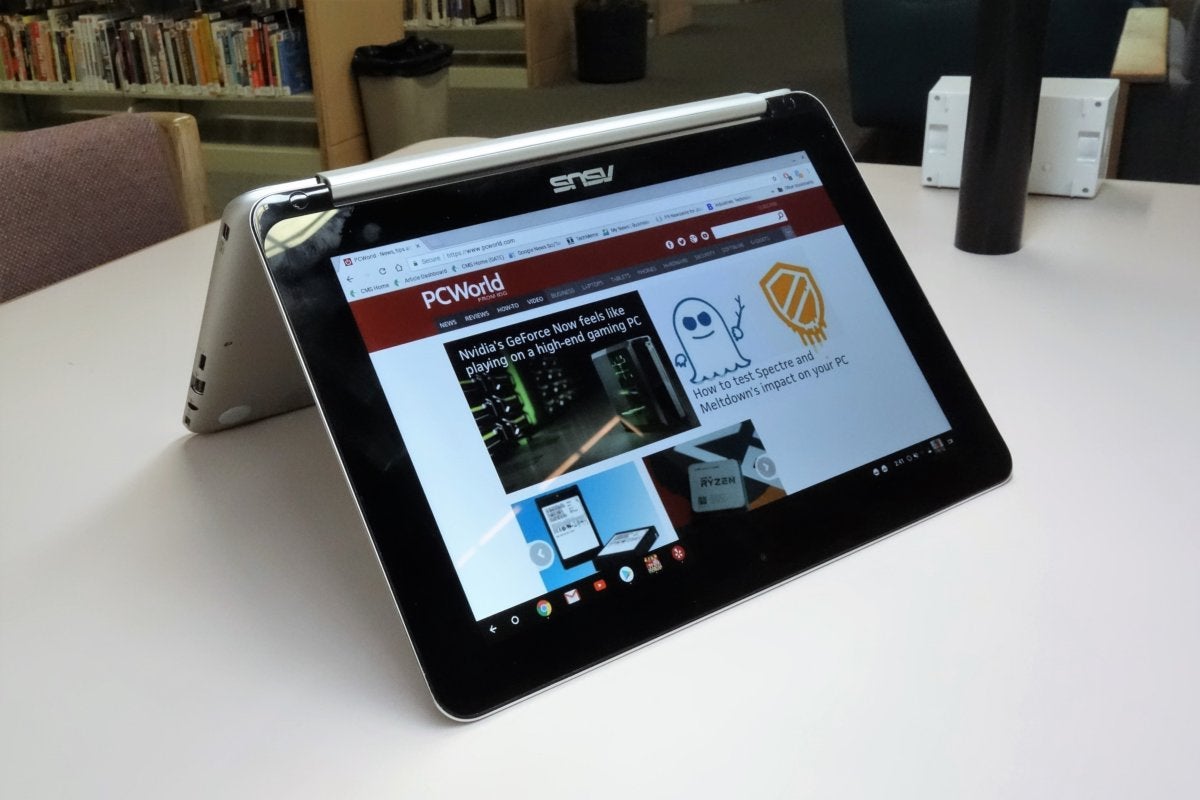 Mark Hachman / IDG
Mark Hachman / IDG The Chromebook Flip effortlessly folds back into tent mode, and from there into a pill configuration.
Chromebook Flip specs and features
The Chromebook Flip is small, thin, and light, which agency you'll inevitably do up short on some features that only won't fit into the anatomy. The specs and features on this small Chromebook are adequate, though I'll get into some shortcomings afte.
Display: 10.1-inch LED touchscreen, 1280×800 pixels
Mainframe: 2GHz Rockchip RK3399 (OP1)
RAM: 4GB LPDDR3
Storehouse:16GB eMMC (10.3GB usable)
Ports and peripherals:
- Two USB 3.1 Type C ports
- One USB 3.0 Type A port
- MicroSD carte du jour reader
- HD webcam
Tune:802.11ac
Weight: 1.96 pounds measured (2.32 pounds with charger)
Dimensions: 10.4 x 7.2 x 0.6 inches
Stamp battery life: 9 hours (rated)
Price (MSRP): $299 happening Amazon
Some Chromebook makers seem to favor a brushed-atomic number 13 chassis, sooner than the cheaper fictile of archaic. The Chromebook Flip C101PA-DB2 follows cause, giving it a misleadingly toughened search. A central hinge allows the tablet to recline essentially 360 degrees, back through a collapsible shelter shape into tablet mode.
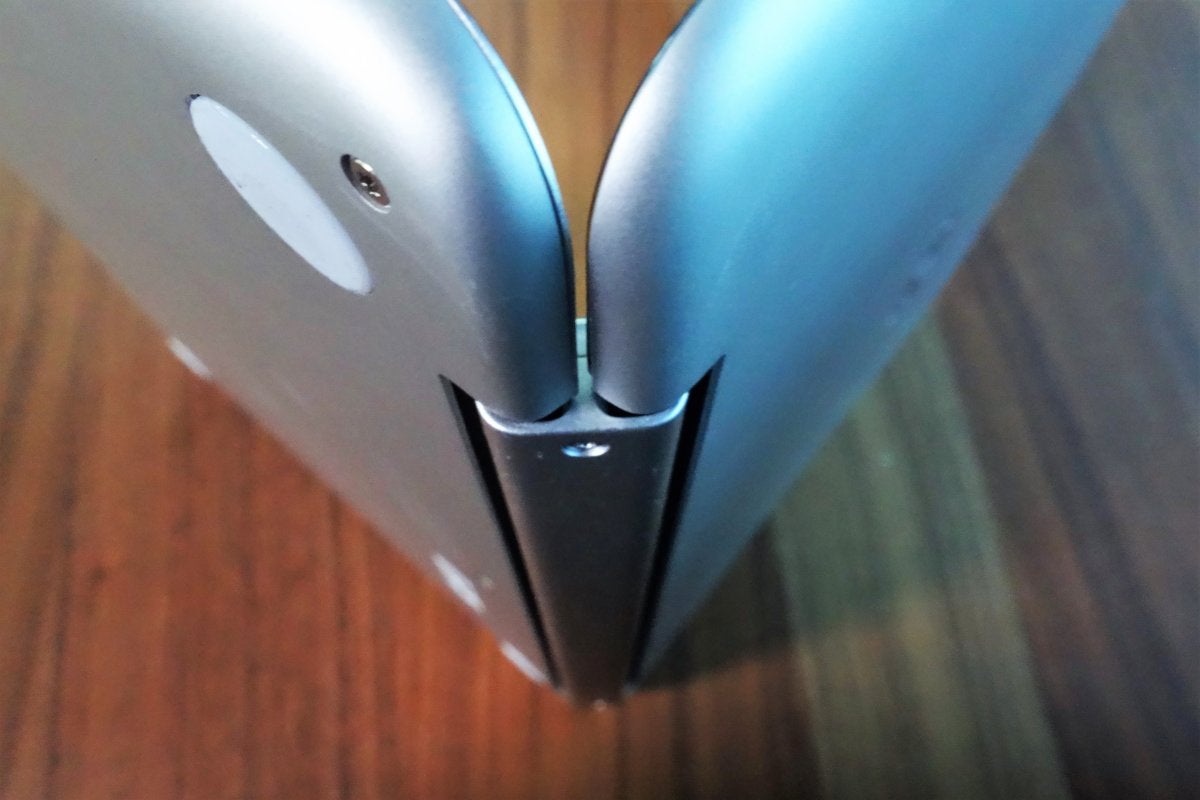 Mark Hachman / IDG
Mark Hachman / IDG A sturdy hinge allows the Flip to rotate well-nigh 360 degrees, foldaway second on itself.
The Summerset's display suits its relatively small size. The screen looks noticeably brighter when viewed from the front, which is true of well-nig LED-lit panels, simply its 178-degree viewing tip over makes images visible even when looking from the broadside.
Note that the resolution is specified as 1280×800 pixels, which is its "Best" mode. If you exit into the Device fare in Settings, you'll find a virtualized 1440×900 option that increases the resolution at the cost of a trifle of blurring or fuzzing.
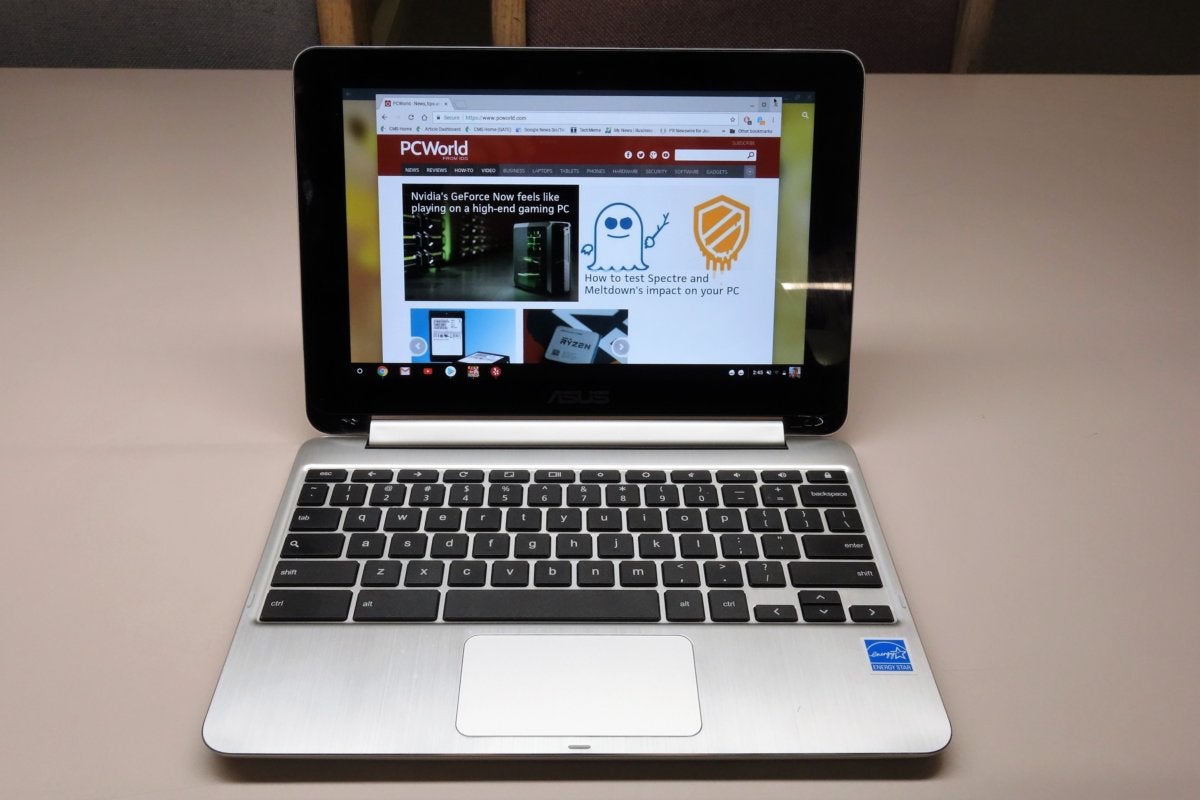 Mark Hachman / IDG
Mark Hachman / IDG There's nothing too unparalleled or so the Chromebook Flip's keyboard, save for its small size of it.
Asus embedded the Flip's speakers inside the keyboard, not the tab equally all but manufacturers of tablets and two-in-ones do. Those down-ignition 80dB internal speakers generated an about overpowering volume of righteous when playing back Kanye Westernmost's "All of These Lights," with the effectual reverberating off the work opencast. Typical of laptops and Chromebooks, the sound is disappointingly flat connected the low end, though headphones resolve most of those issues.
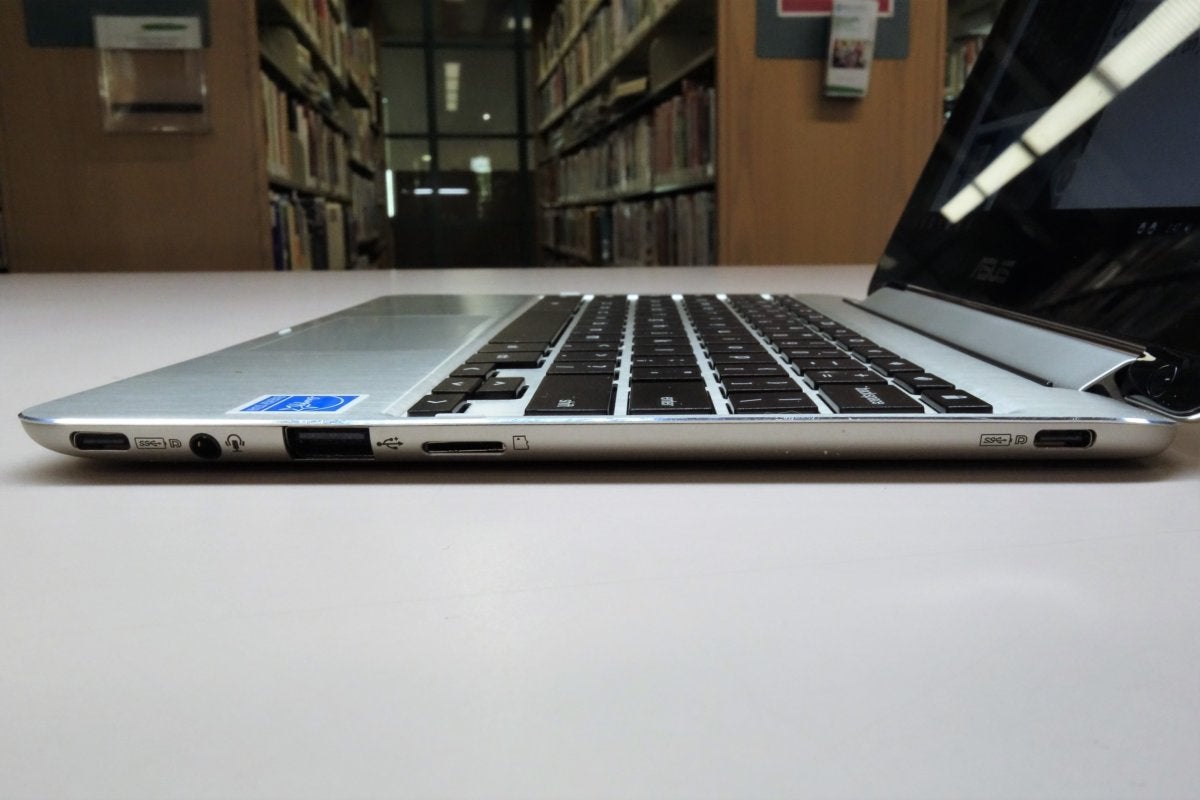 Mark Hachman / IDG
Mark Hachman / IDG Piece the Flip encourages you to invest in USB-C peripherals, a legacy USB-A porthole is a convenient addition.
The internal eMMC storage is supplemented past an SD card slot. If this were a regular tablet with a rear camera, you might rightly be taken up that the SD card would fill apace with images. However, the Chromebook Flip doesn't have a rear television camera (IT would cost blocked by the keyboard as it folds over), then the surplus storage volition likely be available for Humanoid apps.
Typing go through
The Flip's keyboard is other drawback, as the compact form factor—nearly a full inch narrower than a standard background keyboard—will likely cramp most adult fingers. To be fair, I was able to character accurately, though I for certain didn't want to do so for extendible periods. The touchpad, though also connected the small side, offers decent feel and responsiveness.
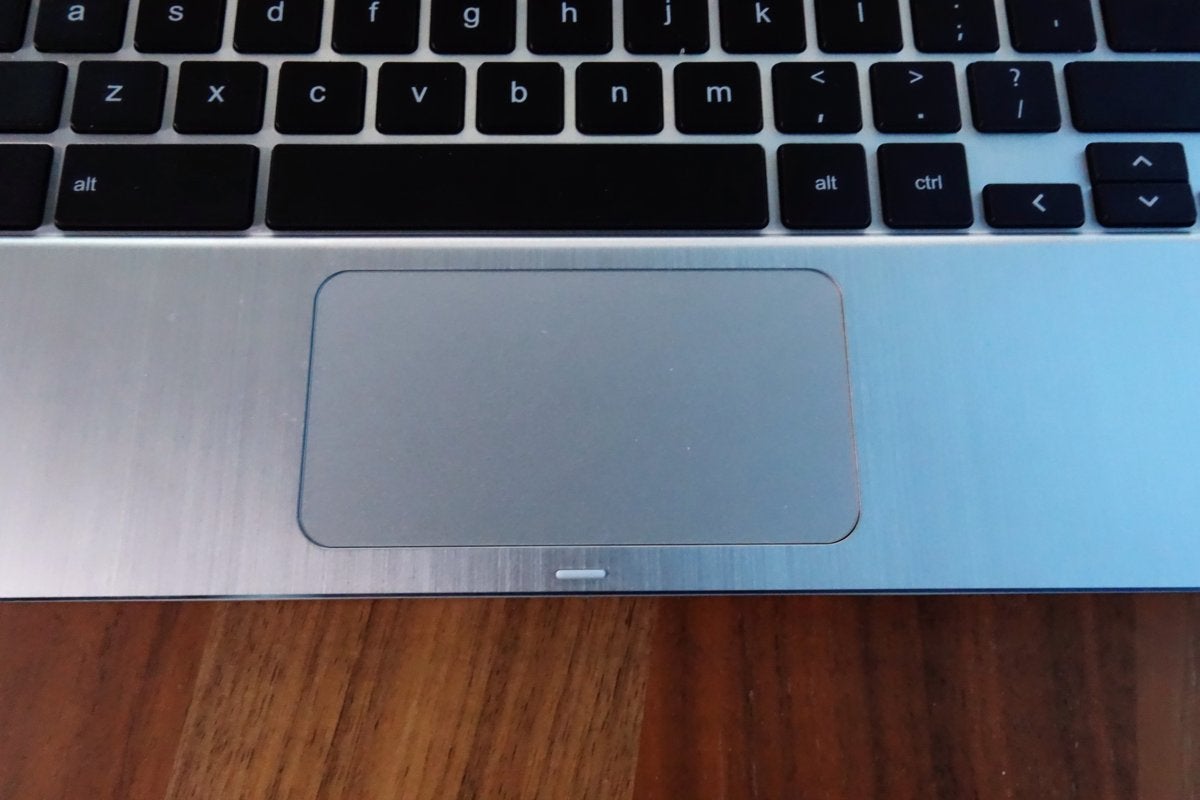 Mark Hachman / IDG
Mark Hachman / IDG The Flip's touchpad is comfortable and responsive.
Interestingly, my 10-year-old son felt otherwise. Chromebooks have become a staple of American classrooms, and my son has victimised a Chromebook daily for at any rate deuce years. He had zero issue with either the smaller screen size or the keyboard, and reported that the keyboard was flatter and easier to type upon than those on new Chromebooks he's used. Knowing who you'll buy the Flip for—yourself? your kids?—Crataegus laevigata affect your decision.
Humanoid support feels almost fully sunbaked
Though Chromium-plate OS added support for Android apps aboriginal in 2017, the feature spent most of the year in a sort of limbo. Mechanical man apps on Chromebooks were technically beta products, and only the almost recent hardware supernatant Android.
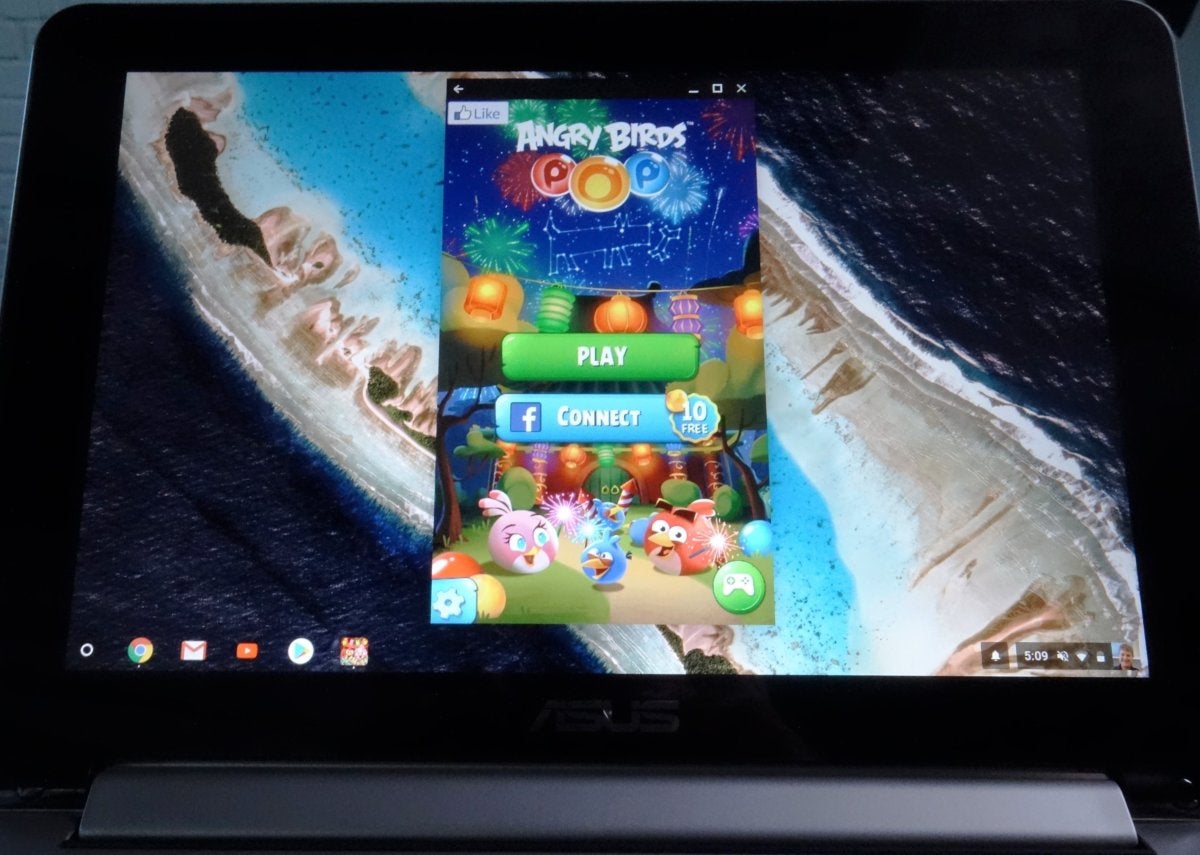 Mark Hachman / IDG
Mark Hachman / IDG In background mode, Android apps simply don't, and can't, trespass of the block out orientation.
A class along, the situation is steadier, if still not idyllic, given the challenges of translating Mechanical man onto a Chromebook. Google Maps still plants a hierarchical chromatography column of recommended sites inside the "Explore" check of the Google Maps app, for illustration, as it did last year. In desktop mode, launching a vertically-homeward game same Angry Birds Pop carved down a narrow slice of my screen containing the game.
Switching the screen back into tablet style reoriented and resized the game then that IT filled the entire screen in portraiture mode. The process wasn't instantaneous; as a matter of fact, it took several seconds for the Summersault to resize and reorient the game, during which the display was worryingly covert and apparently insensitive.
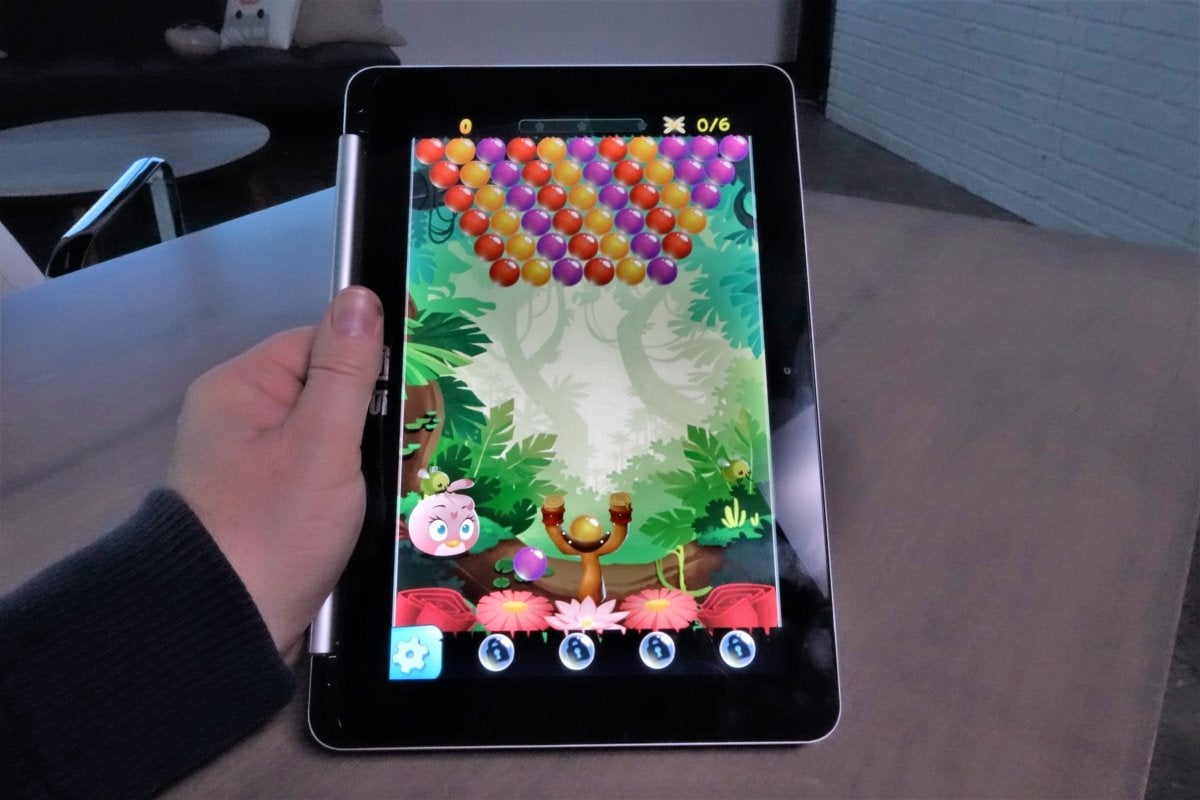 Mark Hachman / IDG
Mark Hachman / IDG Flip the Flip's screen support, though, and suddenly you have a large Android pad.
However, the basic signal stands: In tablet mode, the Pitch acts like an Android tablet. If you load desktop-like Android apps like Microsoft Word or native Chrome apps like Google Sheets, the Flip mimics a desktop PC. When things click into place decent, it's the better of both worlds.
Just remember that fated apps are optimized for phones, rather than for computers pretending to be phones. Because the Flip lacks GPS, for example, Yelp must use Wi-Fi to approximate your localisation. And forget about playing Pokemon Go—the Flip lacks the necessity rear camera.
How the Leaf's OP1 chip performed in the real world
Chances are that you'll buy a Chromebook without once considering the chip inside of it, but the Flip's is worth noting. IT uses a microprocessor made by Rockchip, a Chinese microprocessor architect you've probably never heard of. And that's the point: Google rebranded the bit the OP1, apparently in a bid to pull through a bit sexier and absent any concerns about buying a Chromebook that's powered by an unknown manufacturer. A previous version of the Chromebook Flip that we tested officially uses the Rockchip RK3288.
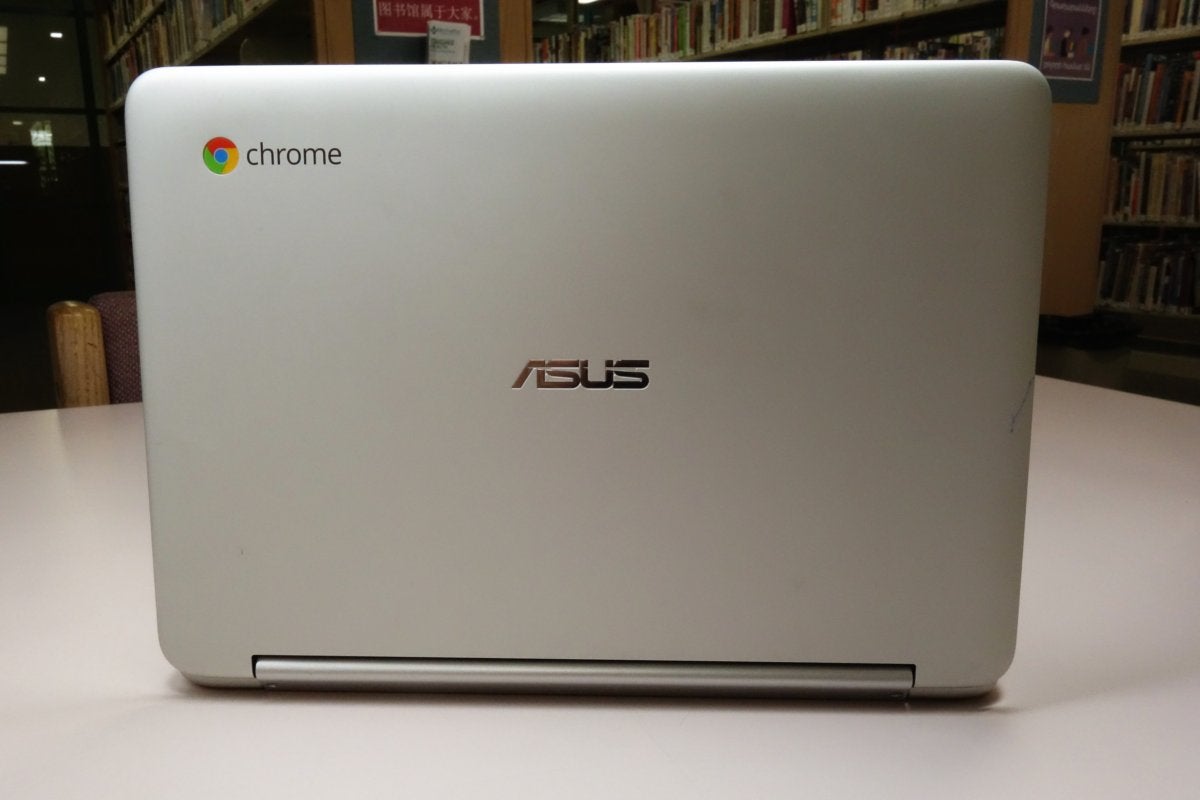 Stain Hachman / IDG
Stain Hachman / IDG Inside the OP1 (or the Rockchip RK3399, if you favour) is an Gir chip, specifically a dual-core Cortex-A72 and quadruplet-core Cortex-A53 with unshared NEON coprocessor, aboard a French Sudan T860 MP4 GPU. Build up licenses these cores to companies like Qualcomm, Samsung, and Rockchip, which can pluck and combine them as they'd like. In precise full strokes, what the OP1 does is compound the A72 cores used by 2016 smartphones with separate CPU cores that emphasize low power.
Essentially, the Flip packs a more powerful variation of the Samsung Extragalactic nebula Note 7 smartphone below the cowl, with a NEON media accelerator betrothed to IT. (And for those of you who remember the Note 7 recall, don't concern—it was the shelling that was at fault, not the microprocessor.)
Chances are that any stake an Mechanical man telephone set can tackle, the Asus Chromebook Flip can, too. My experience echoed that: Games like Mineral pitch 8, a bang-'mutton-up colonnade racer for Android, ran swimmingly, as did a number of other Android apps I tried out. Though neither YouTube nor Netflix will output 4K video to a machine that can't support IT, the Flip smoothly rendered video from some sites.
Victimisation a "reverse KVM" gadget especially sourced from Korea, we even performed some incomparable straits-to-head testing against an HP Chromebook 13, powered by an Intel Core m. Using a single mouse and keyboard to control both machines simultaneously, we opened a 12 Chrome tabs and navigated around different sites. Piece the Flip was very slightly laggier and bumpier while scrolling functioning and down, our ratiocination is that you'd only notice when straightaway comparing the cardinal. Given that HP's Chromebook costs $500 much, that's a strong warrant of the Flip's bang for the one dollar bill.
How the Leaf compares to opposite Chromebooks
When we officially benchmarked the Chromebook Flip, we sought to compare information technology with other lower-end Chromebooks, running mostly Celeron processors (plus we threw in the aforementioned experienced, Rockchip-powered Chromebook Flip). These tests put the Chromebook Interchange in the in-between of the pack—not too shabby, really, for a $250 to $300 machine.
One caveat about our performance charts: Because Google updates Chrome OS every six weeks or so, from a software perspective we're essentially comparing hot apples to older apples. The Asus Chromebook Flip ran Chrome OS build up 63.0.3239.140, piece all the opposite machines in our charts were benchmarked on earlier versions.
Each synthetic test we use stresses the Chromebook in some way, from generic productivity tasks to peculiar functions. The first, Cr-XPRT, is correspondent to the WebXPRT tests we purpose to evaluate web browsers, but optimized for Chromebooks. It evaluates performance in basic productiveness tasks like word processing, as well as more demanding activities look-alike watching movies or playing games. While the honest-to-god Chromebook Flip brings up the rear, the latest Chromebook Flip advances to a massive midpack position.
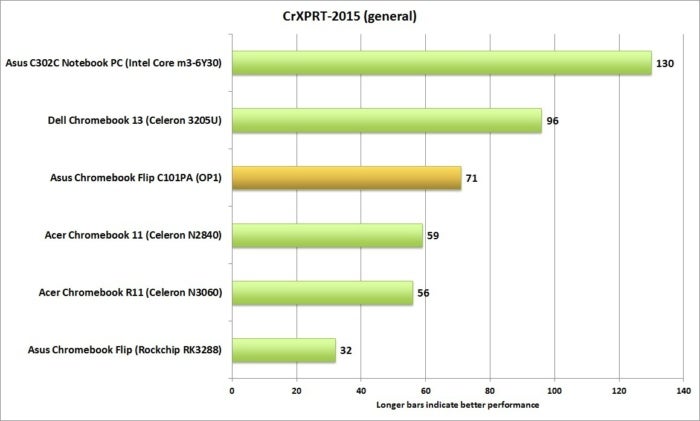 Melissa Riofrio/IDG
Melissa Riofrio/IDG Spell a Nub M3-based Chromebook easy outpaces the Asus Summerset, its OP1 Rockchip chip runs with the Intel Celeron pack.
The Basemark benchmark dives into everything from real-clock graphics using WebGL 1.0.2 and WebGL 2.0 to detailed JavaScript tests. Here, the newer Chromebook Impudent beats a few Celerons, while remaining far behind a Core m3 machine.
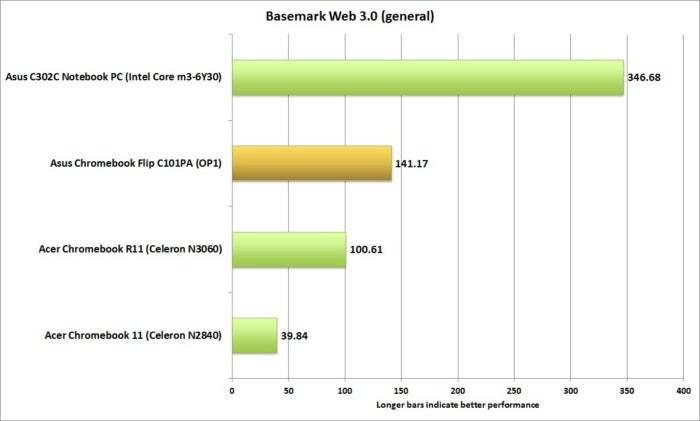 Melissa Riofrio/IDG
Melissa Riofrio/IDG Over again, higher-performance Nucleus founded chips steal the execution tip, but the Flip still does symptomless.
Kraken, authored away Mozilla, takes a different approach, diving deeper into JavaScript. It measures the speed of several different test cases extracted from real-world applications and libraries. The Chromebook Flip falls into the trailing middle pack.
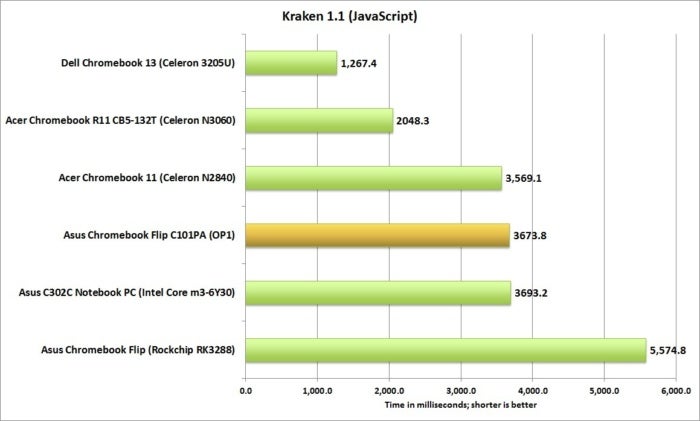 Genus Melissa Riofrio/IDG
Genus Melissa Riofrio/IDG The Asus Flip is comfortably in the eye of the pack as measured aside the Kraken benchmark.
To estimate a Chromebook's, battery life, we role Cr-XPRT's synthetic battery test, standardizing the results by setting the presentation to 200 nits and connecting headphones with the loudness at 50 percent. The Flip performs well, with a sticking spirit of almost 10.5 hours—nearly identical to its predecessor's time.
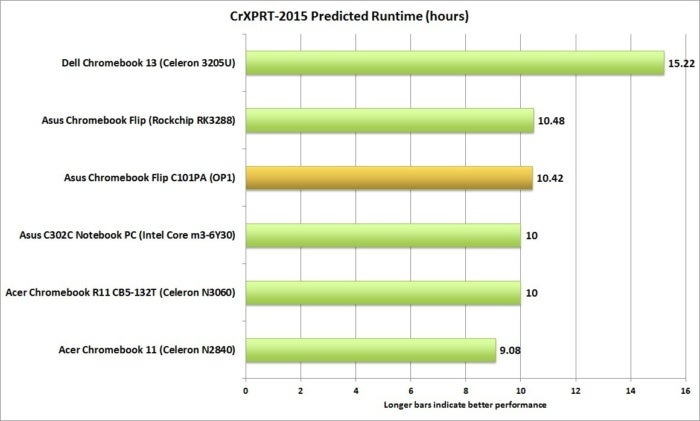 Melissa Riofrio/IDG
Melissa Riofrio/IDG Stamp battery life is another expanse where the Flip performs acceptably.
Closing: Business in the front, party in the back
By now, most of U.S. probably call up of Chromebooks as a catchall category, with individual models distinguishing themselves via incremental nudges in performance and battery life. High-priced Chromebooks suchlike the Google Pixelbook reside in their own niche, trying to emulate the Leontyne Price and performance of a PC.
The Chromebook Flip feels like something new: the nuclear fusion reaction of the sized Android tab with a Chromebook. Nature doesn't necessarily prefer new mutations. The Flip feels a bit large-scale for a tablet, and slightly excessively small for a Chromebook. But one thing seems careful: If a Chromebook supports Android, information technology needs to be a convertible. Here, the Rif has the right thought.
Source: https://www.pcworld.com/article/407952/asus-chromebook-flip-c101pa-review.html
Posted by: redmonprecalf.blogspot.com


0 Response to "Asus Chromebook Flip (C101PA) review: Is this convertible the future of Android tablets? - redmonprecalf"
Post a Comment